In this digital day and age, it’s increasingly important to have an understanding of how each touchpointA point of interaction between a customer and a brand. influences a customer’s journey to make more informed, educated marketing decisions.
One of the best ways to do that is to apply Data-Driven AttributionThe process of assigning credit to various marketing interactions for a conversion. in Google Ads.
Data-driven attribution has become a real game-changer for helping advertisers like you understand which interactions significantly contribute to conversions.
Unlike traditional models, data-driven attribution relies on actual data to distribute credit across the journey, enabling wiser budget allocations and refined strategies.
By focusing on data-driven insights, marketers can move beyond last-clickAn attribution model that gives all credit to the last interaction before conversion. approaches that miss much of the complexity in the journey.
In this guide, you will learn exactly how data-driven attribution works, why it matters, and how you can use it for maximum results in your Google Ads campaigns.
Whether looking to raise your ROI, optimize ad placements, or otherwise gain a better grasp of customer behavior, data-driven attribution represents the most accurate and holistic view of your marketing efforts.
- Understanding Data-Driven Attribution in Google Ads
- Setting Up Data-Driven Attribution in Google Ads
- Analyzing Performance with Data-Driven Attribution
- Benefits and Challenges of Data-Driven Attribution
- Best Practices to Fully Maximize Data-Driven Attribution
- Final Thoughts on Data-Driven Attribution in Google Ads
- Commonly Asked Questions About Data-Driven Attribution in Google Ads
Understanding Data-Driven Attribution in Google Ads
To use data-driven attribution effectively, one really has to begin with an understanding of what it is and how it differs from other attribution models.
Simply put, data-driven attribution uses machine learningA form of artificial intelligence that enables systems to learn from data. to attribute credit across the conversionA desired action taken by a user, such as a purchase or sign-up. path based on actual user data.
This means it makes no general assumptions but instead learns from your specific campaigns to understand exactly how each interaction drives conversions.
In doing so, it allows advertisers to see more clearly which channels, ads, and keywords actually drive results.

Understanding Data-Driven Attribution in a collaborative digital marketing workspace.
What is Data-Driven Attribution?
Data-driven attribution in Google Ads is an attribution model that uses machine learning to study the unique contributions of different ads and keywords leading to a conversion.
Unlike rule-based models, such as last-click or first-clickAn attribution model that credits the first interaction in a user's journey., it relies on actual user interaction data to allocate credit.
Google algorithms analyze multiple touchpoints a customer has with your brand and assign value to each, showing how each interaction contributes to a conversion over time.
This model helps you avoid attributing all the credit to the last touchpoint, providing a clear picture of the buyer’s journey.
Data-driven attribution is more accurate because it considers multiple data points for each user.

Exploring the importance of data-driven attribution in digital marketing.
Why Is Data-Driven Attribution Important?
Data-driven attribution allows you to make more intelligent decisions in your advertising strategy.
Traditional attribution models simply do not capture the nuances of a typical consumer journey.
With data-driven attribution, you can:
- Discover impactful channels and touchpoints that may be missed by a rule-based model.
- Optimize your budget by understanding which touchpoints create the most value.
- Improve ad performance by focusing on touchpoints resulting in positive conversions.
If implemented correctly, data-driven attribution lets you refine your approach using real, data-backed insights instead of assumptions, ensuring that your marketing dollars are well spent.

Analyzing differences between data-driven attribution and other attribution models.
How Data-Driven Attribution Differs from Other Models
Data-driven attribution stands apart from other attribution models primarily because it’s based on machine learning.
For instance, last-click attribution credits the very last touch, while linearAn attribution model that distributes equal credit across all interactions. attribution evenly distributes credit across all touches.
In contrast, data-driven attribution uses actual user data to determine the relative value of each touch.
This approach means you aren’t constrained by inflexible assumptions; instead, Google’s algorithms adapt to your data, showing how each ad interaction influences conversions.
For advertisers, this distinction means access to insights that are tailored to their unique customer journeys.

Overview of various Google Ads attribution models in a digital marketing workspace.
Google Ads Attribution Models Overview
In Google Ads, several attribution models are available, including last-click, first-click, linear, time decayAn attribution model that credits interactions closer to conversion more heavily., position-based, and data-driven.
Here’s a quick look at each:
- Last-Click: Credits the final interaction before a conversion.
- First-Click: Credits the first interaction in the journey.
- Linear: Distributes credit equally across all interactions.
- Time Decay: Heavily credits interactions closer to the conversion.
- Position-Based: Allocates 40% to the first and last interactions, with the remaining 20% distributed across middle interactions.
- Data-Driven: Credits each interaction based on its real contribution.
Understanding these models and how they apply to different scenarios allows you to select the model that best aligns with your goals and customer journey.
With data-driven attribution, you gain a perspective that is continuously refined based on real campaign data, making it the most dynamic and accurate model available in Google Ads.
Data-driven attribution leverages machine learning to credit touchpoints accurately, offering deeper insights than traditional models.
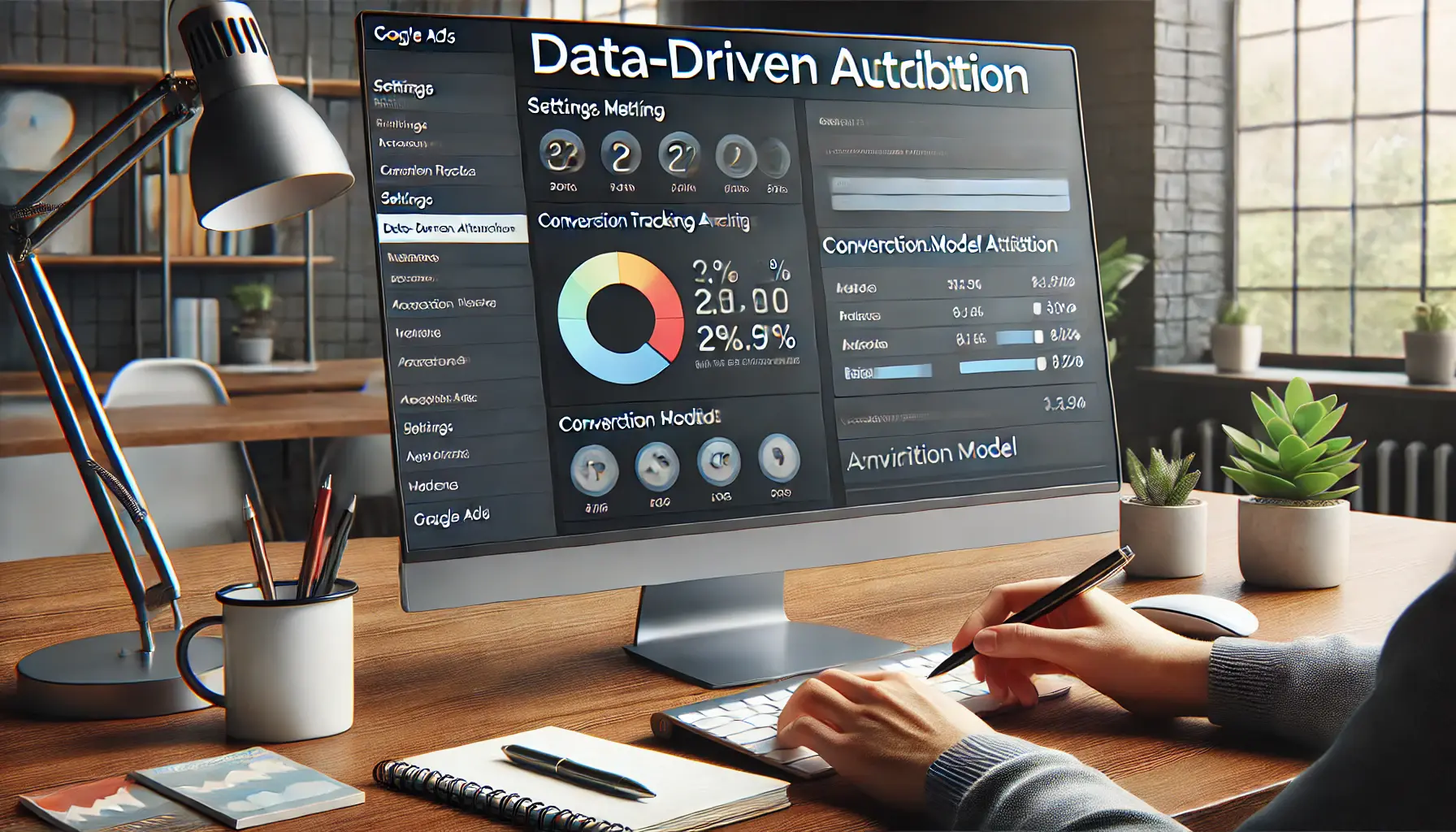
Configuring data-driven attribution settings in Google Ads for optimized conversion tracking.
Setting Up Data-Driven Attribution in Google Ads
Setting up Data-Driven Attribution in Google Ads lets you understand how each interaction with your ad drives conversions.
However, it does require some initial setup to ensure accurate data capture.
Google Ads makes this process straightforward, but proper configuration from the start is essential.
Here’s an in-depth look at the setup process and the tools that can assist in enriching your data-driven approach.
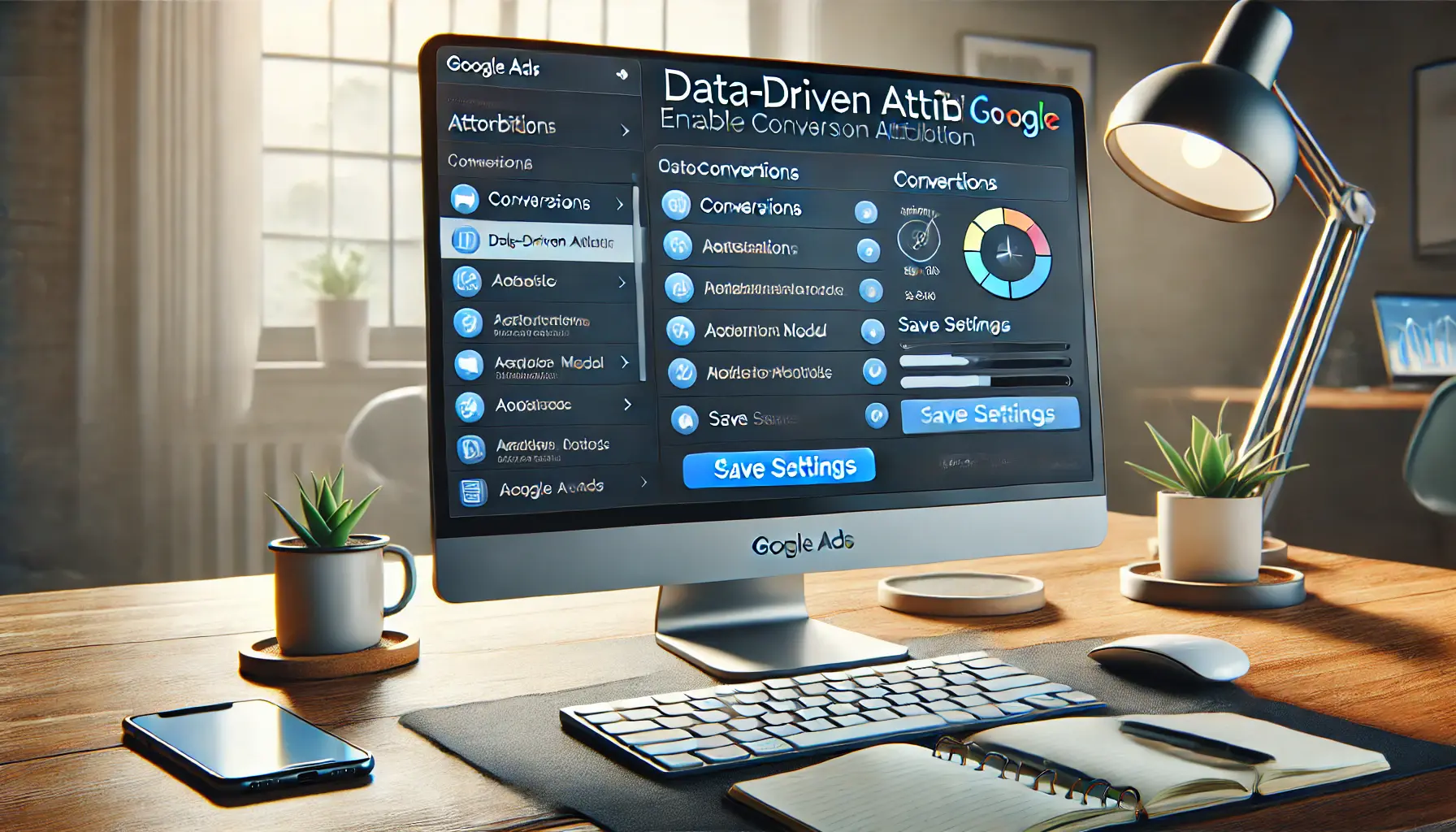
Enabling data-driven attribution with step-by-step configuration in Google Ads.
Steps to Enable Data-Driven Attribution
To enable data-driven attribution, start by going to the ‘Conversions’ menu within your Google Ads account and following these steps:
- Go to Conversions: Under ‘Tools & Settings,’ click on ‘Conversions.’ This is where you can manage and create conversion actions.
- Select Conversion Action: Choose the specific conversion you want to apply data-driven attribution to, such as a sale or lead.
- Modify Attribution Model: Within the selected conversion, under ‘Attribution model,’ select the data-driven attribution model.
- Save and Monitor: Save your modified settings and monitor performance over time to see how data-driven insights adjust with real user behavior.
This model is only available if your campaigns have sufficient conversion data for Google’s algorithms to create reliable attributions.
Google may require a minimum volume of conversions over a 30-day period to activate the data-driven model effectively.

Setting up accurate conversion tracking in Google Ads for precise attribution.
Configuring Conversions for Accurate Attribution
Accurate conversion tracking is essential for effective data-driven attribution.
Ensure that conversions are set up to reflect your key business goals accurately.
For instance, defining key conversion actions could include purchases, sign-upsA conversion action where users register for a service or newsletter., or other important interactions.
Here are steps to configure conversions accurately:
- Use Google Tag Manager: Add tags on your website or app to track interactions with your ads precisely.
- Set Conversion Windows: Configure the conversion window, or the period within which a post-ad interaction will count as a conversion, usually set between 7–30 days.
- Enable Cross-Device Tracking: Enable cross-device tracking to understand the entire customer journey, as users may interact with your brand on multiple devices.

Integration of Google Analytics with Google Ads for comprehensive marketing insights.
Integrating Google Analytics for Enhanced Insights
Integrating Google AnalyticsA tool providing insights into website traffic and user behavior. with Google Ads provides additional insights into your data-driven attribution.
When linked with Google Ads, Analytics provides extra dimensions of user behavior and paths to conversion, which can further enhance your ad performance insights.
Here’s how to integrate effectively:
- Link Google Analytics and Google Ads: Go to the Google Analytics admin panel and connect it with your Google Ads account. This integration enables Google Ads to pull data from Analytics for better attribution insight.
- Enable Goals and Events: Establish goals and events within Google Analytics, such as ‘Pageviews’ or ‘Sign-Ups,’ to track key interactions in your conversion funnel.
- Use Multi-Channel Funnels: Leverage Analytics’ multi-channel funnels to view conversion paths across channels. These can validate your data-driven model’s findings and offer a full view of all touchpoints.
- Analyze User Flow: The User Flow in Analytics shows how visitors navigate through your site before converting, potentially revealing additional touchpoints.
This integration is invaluable for advertisers refining their approach with data-driven attribution, as it provides a comprehensive view of performance beyond Google Ads alone.

Troubleshooting common setup issues in Google Ads for accurate attribution.
Common Setup Issues and Troubleshooting Tips
While setting up data-driven attribution is generally straightforward, a few common issues may arise:
- Insufficient Conversion Data: Data-driven attribution requires a minimum amount of conversion data. If you see an error or lack of availability, try increasing conversions through other models until enough data is gathered.
- Incorrect Tagging: Misconfigured tags can lead to inaccurate tracking. Verify that Google Tag Manager and conversion settings are correctly set up to ensure tags fire as intended.
- Inaccurate Attribution Window: If you find conversions attributing outside a relevant timeframe, adjust your attribution window to ensure accuracy.
- Cross-Device Reporting: Enable cross-device tracking to avoid gaps in data when users switch devices before converting.
Addressing these common issues will help you capture accurate data and make the most of your data-driven attribution, maximizing the precision of your insights.
Setting up data-driven attribution correctly is essential for capturing accurate conversion paths and optimizing ROI.

In-depth analysis of ad performance using data-driven attribution in Google Ads.
Analyzing Performance with Data-Driven Attribution
Once you have set up Data-Driven Attribution in Google Ads, analyzing data effectively becomes crucial to understanding the value of each touchpoint in your campaigns.
By accurately interpreting these insights, you can optimize ad strategies, refine targeting, and allocate budgets to maximize conversions.
This section explores the various ways to analyze performance using data-driven attribution, helping you leverage your Google Ads data to its fullest potential.

Understanding insights from data-driven attribution reports in Google Ads.
Interpreting Data-Driven Attribution Reports
Data-driven attribution reports offer a unique view of each interaction’s contribution to conversions.
Here’s how to interpret these reports for actionable insights:
- Conversion Path Analysis: Review the paths that users take from their first interaction to conversion. These paths help you identify the most common routes leading to success, which can be used to optimize your ad spend.
- Assisted Conversions: Examine conversions where certain keywords or ads played a supportive role, rather than directly converting. Assisted conversions show which ads are helpful in driving engagement at various stages.
- Top Conversion Paths: Identify your top conversion paths to reveal the typical journey taken by your audience before converting. This helps you focus on top-performing channels or touchpoints.
Each of these metrics highlights the role that different touchpoints play in driving conversions, allowing you to adjust your strategy based on real user behavior.

Monitoring key performance metrics in data-driven attribution within Google Ads.
Metrics to Monitor When Using Data-Driven Attribution
To measure the effectiveness of data-driven attribution, it’s important to monitor key metrics that reflect campaign performance and user behavior:
- Conversion Rate: Track the overall conversion rate, which shows the percentage of users completing desired actions after interacting with your ad.
- Cost per Conversion: Determine the cost per conversion to understand how much you’re spending on particular touchpoints, helping optimize budget distribution across different channels.
- Path Length: Monitor the average path length to see the number of touchpoints typically involved before a conversion, which provides insight into the complexity of the customer journey.
- Comparison to Other Attribution Models: Use Google Ads’ model comparison tool to compare data-driven attribution with other models, allowing you to see the impact of each model on your conversion data.
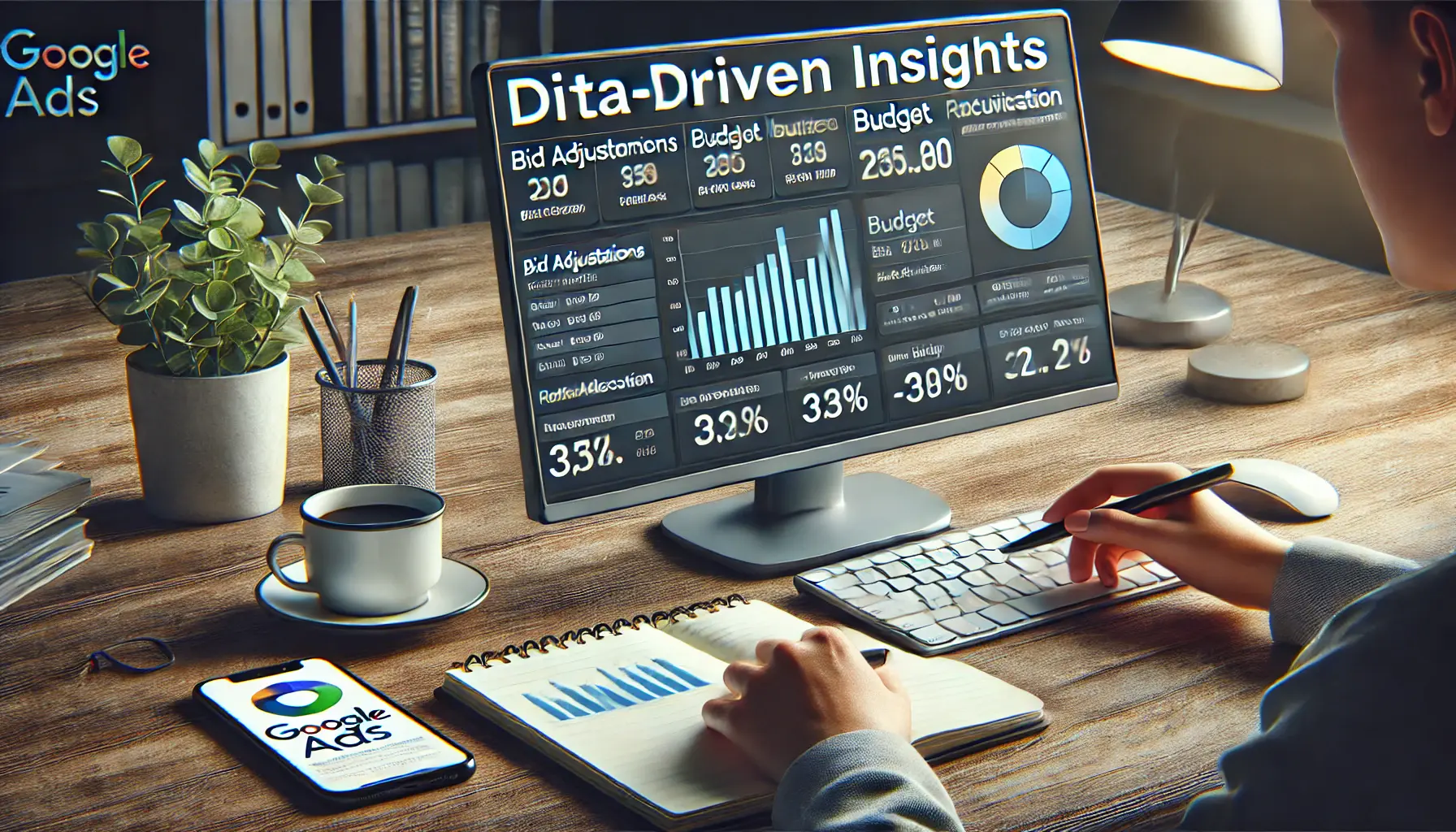
Optimizing campaigns in Google Ads using data-driven insights.
Using Data-Driven Insights to Optimize Campaigns
Data-driven attribution insights can be used to refine your Google Ads strategy for better results.
Here’s how to use these insights effectively:
- Bid Adjustments: Make bid adjustments based on the value each keyword or ad brings to conversions. Data-driven attribution helps you understand which ads and keywords have the most influence in driving conversions at various stages of the funnel.
- Reallocate Budget: Invest more in ads and channels that demonstrate higher contribution to conversions, maximizing ROI across all touchpoints.
- Optimize Ad Messaging: Use insights from conversion paths to craft messages that align with the customer journey, catering to different stages to improve engagement and conversion rates.
By applying these optimizations, you can enhance Google Ads performance, drive conversion rates, and increase return on ad spend (ROAS).

Exploring real-world applications of data-driven attribution in Google Ads.
Examples of Data-Driven Attribution in Action
To understand the effectiveness of data-driven attribution, consider these examples that illustrate how this model can drive strategic decisions:
- E-commerce Campaigns: An online retailer may use data-driven attribution to find that ads for initial product awareness play a critical role in final conversions. Recognizing these touchpoints enables the retailer to allocate more budget to awareness-focused ads.
- Lead Generation Campaigns: A company running lead generation ads may discover that specific keywords drive engagement but seldom lead directly to conversions. By identifying these assists, the company can adjust keyword bidding strategies.
- Cross-Channel Campaigns: A business using both search and display ads may find that display ads assist conversions initiated by search ads. Recognizing these interactions allows for optimized cross-channel budgets, enhancing overall campaign performance.
These examples demonstrate how data-driven attribution allows marketers to build their strategy based on a full understanding of the customer journey, creating a solid foundation for informed decisions.
Regularly analyzing data-driven attribution reports provides actionable insights for budget and ad optimization.

Evaluating the advantages and limitations of data-driven attribution in Google Ads.
Benefits and Challenges of Data-Driven Attribution
Using Data-Driven Attribution in Google Ads comes with significant benefits, but it also presents some challenges.
Knowing the pros and cons will help you fully leverage this model to improve campaign performance by capitalizing on its strengths and being mindful of its limitations.
This section delves into the key benefits and challenges of adopting data-driven attribution in your Google Ads strategy.
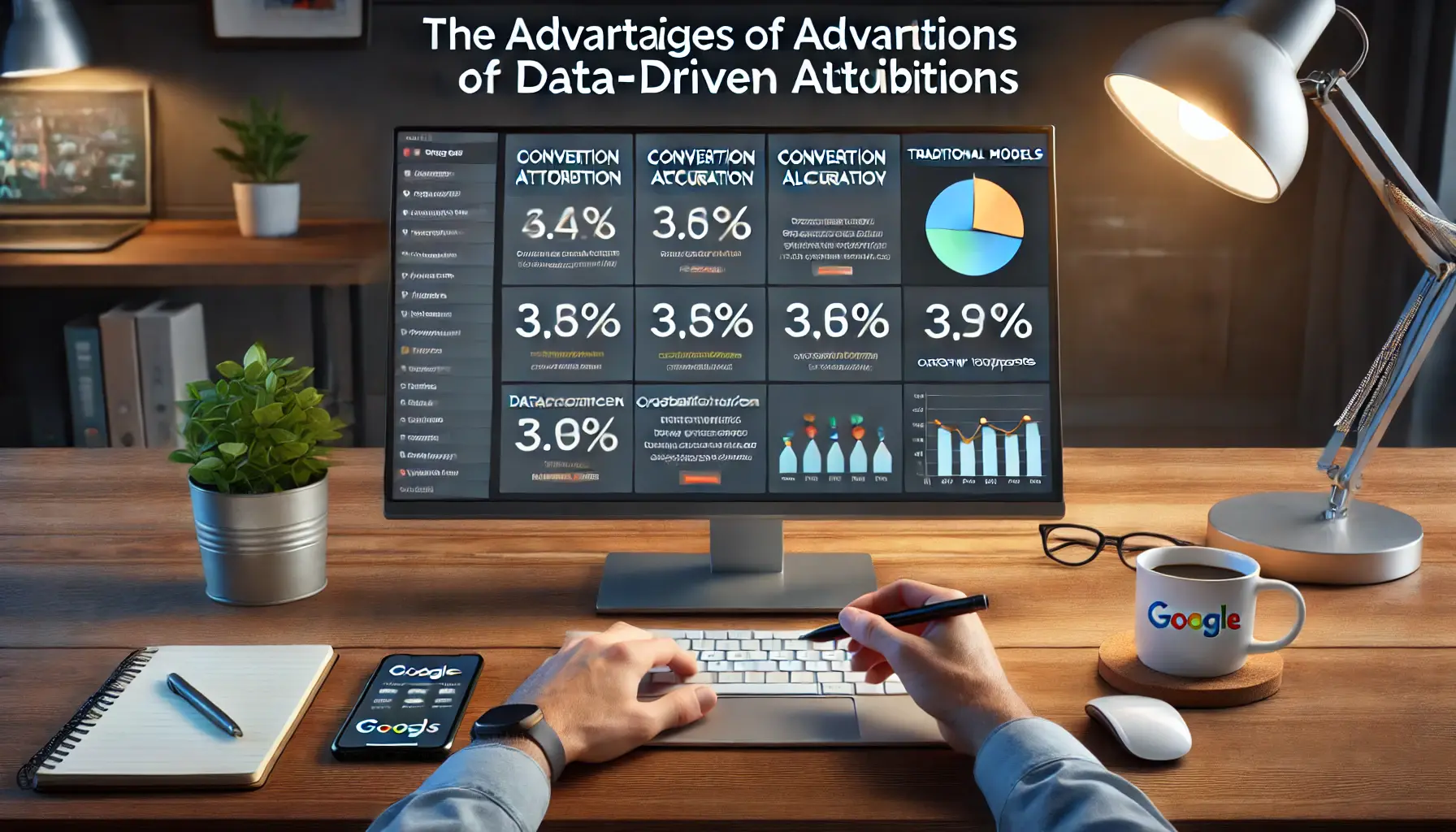
Assessing the advantages of data-driven attribution over traditional attribution models.
Advantages Over Traditional Attribution Models
Data-driven attribution offers distinct advantages over traditional models, making it an essential tool for modern digital advertising.
Here’s how it stands out:
- Increased Accuracy: Unlike rule-based models, data-driven attribution assigns credit based on real performance data, incorporating both cross-device and cross-channel signals for a clearer picture of each ad interaction’s contribution to conversions.
- Campaign Customizable: The machine learning algorithms in data-driven attribution adapt to the specific characteristics of your campaign, providing insights that are unique to your audience and strategy.
- Better Budget Allocation: By identifying the actual touchpoints that drive conversions, you can allocate budgets more effectively to high-impact ads and keywords.
- Dynamic Adaptation: Data-driven attribution continuously learns and adjusts based on incoming data from ongoing campaigns, allowing you to respond quickly to changes in user behavior or market conditions.
These advantages range from offering a more accurate, data-backed view of your campaigns to driving better results and return on investment (ROI).
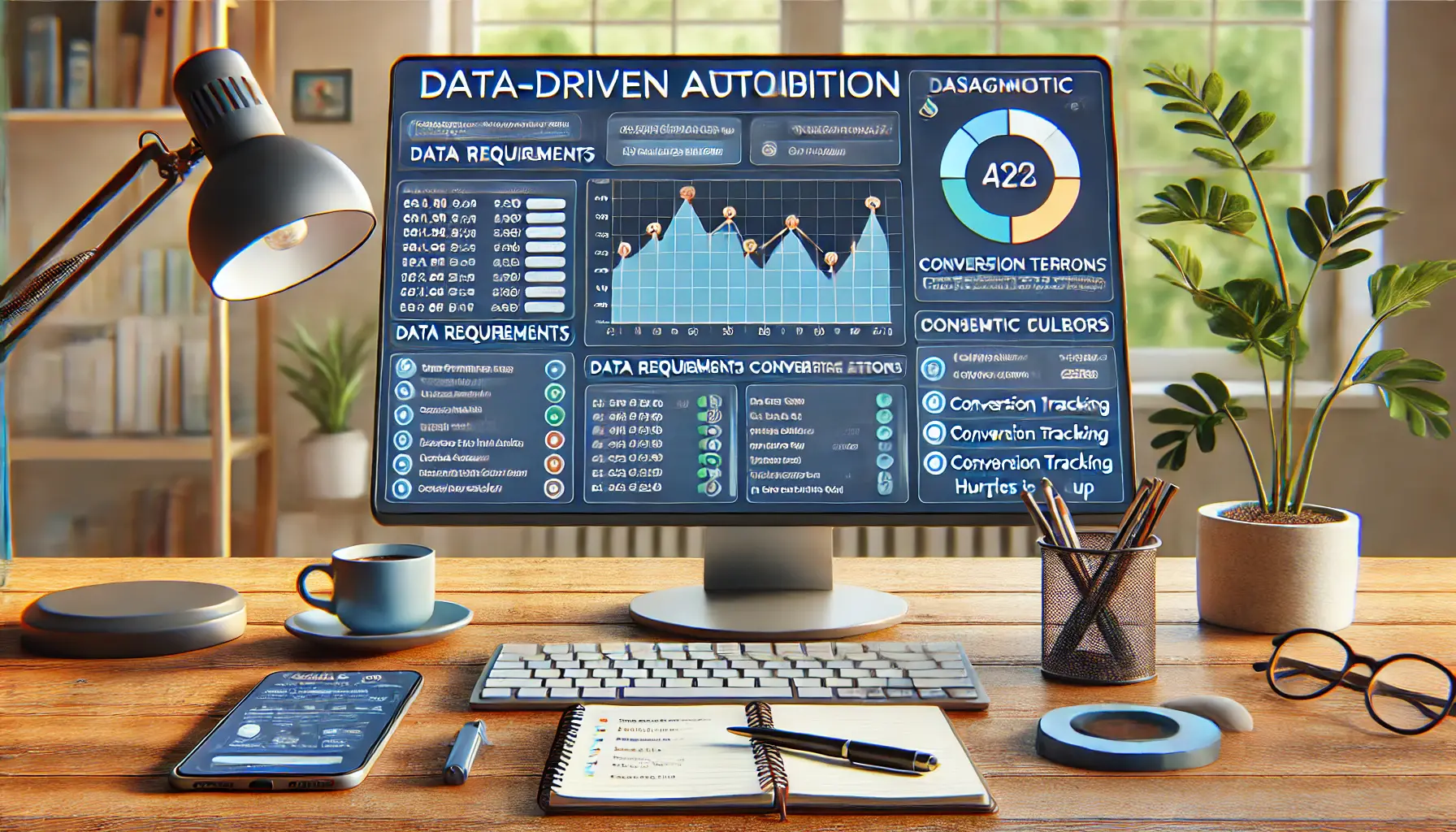
Addressing common challenges in implementing data-driven attribution in Google Ads.
Challenges in Implementing Data-Driven Attribution
While data-driven attribution has many benefits, it also presents certain challenges that are important to consider.
Here are some of the key challenges:
- Data Requirements: Data-driven attribution requires a high volume of conversion data to operate accurately. If your campaigns don’t meet Google’s minimum data threshold, you may not be able to activate this model effectively.
- Complex Setup and Ongoing Monitoring: Setting up data-driven attribution involves careful configuration and requires continuous monitoring. Misconfigured tags, incorrect conversion windows, or cross-device tracking issues can impact data accuracy.
- Limited Availability for Smaller Campaigns: Smaller advertisers or those with fewer conversions may struggle to meet the data threshold for data-driven attribution, limiting their ability to use this model.
- Opaque Attribution Insights: Data-driven attribution is a machine learning model, so its internal operations aren’t always transparent. This can leave advertisers uncertain about how specific attributions are calculated.
Proper setup, adequate data volume, and ongoing oversight are essential for maximizing the accuracy and usefulness of data-driven attribution insights.

Optimizing budget allocation in Google Ads using data-driven attribution insights.
How Data-Driven Attribution Affects Budget Allocation
One of the most impactful benefits of data-driven attribution is its potential to inform budget allocation decisions.
Here’s how it works:
- Highlight High-Impact Touchpoints: Data-driven attribution identifies which touchpoints drive the most conversions, allowing advertisers to allocate budgets to maximize returns.
- Reduce Wasted Spend: By shifting spend away from less effective channels or keywords, you can focus resources on the most impactful touchpoints, reducing waste.
- Support Cross-Channel Optimization: Data-driven insights help guide budget allocation across channels, ensuring that each platform is funded appropriately based on its contribution to conversions.
Using data-driven attribution for budget decisions allows advertisers to make more strategic investments, maximizing return on investment across all ad channels.

Addressing and overcoming common attribution challenges in Google Ads.
Overcoming Common Attribution Challenges
Implementing data-driven attribution can be challenging, but with the right strategies, these obstacles can be managed effectively.
Here are a few solutions:
- Increase Conversion Volume: To meet Google’s data threshold, optimize campaigns to increase conversions using other models initially, until data-driven attribution becomes available.
- Ensure Tag Accuracy: Regularly verify that all tags, conversion actions, and tracking windows are configured correctly to capture accurate data.
- Expand Cross-Device Tracking: Enable cross-device tracking in Google Ads to capture customer journeys across multiple devices.
- Compare with Other Models: Use model comparison tools to evaluate data-driven attribution against other models, ensuring it works effectively for your campaigns.
By proactively addressing these challenges, you can make the most of data-driven attribution and gain valuable insights to enhance your campaigns.
This model provides accurate insights, but be aware of its data requirements and setup complexity.
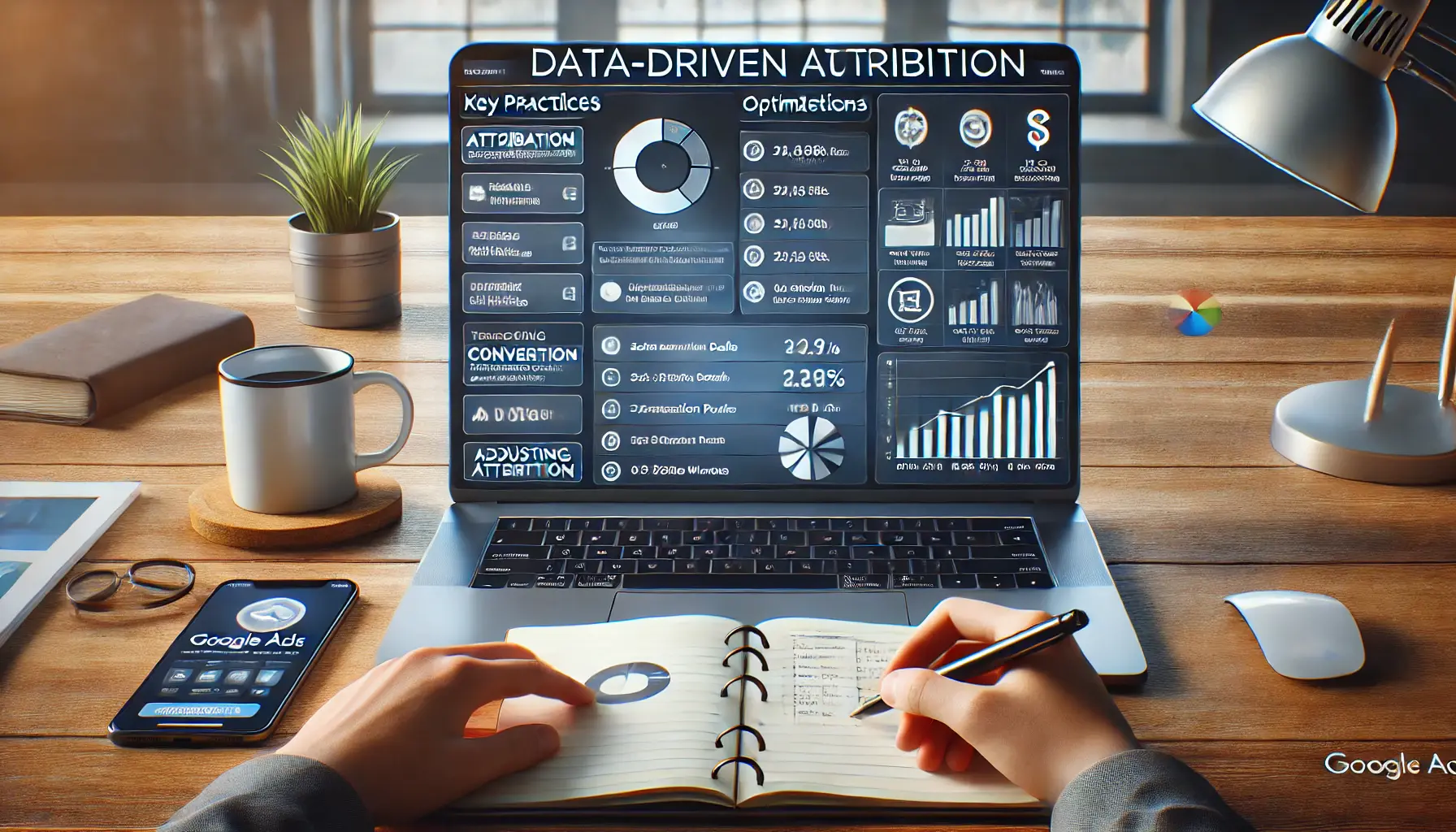
Applying best practices to maximize the impact of data-driven attribution in Google Ads.
Best Practices to Fully Maximize Data-Driven Attribution
Every benefit of Data-Driven Attribution in Google Ads can only be fully realized by following best practices that ensure the model is working accurately.
These best practices not only aid in capturing data correctly but also enable you to apply actionable insights to enhance campaign performance.
This section covers some key strategies to ensure you’re getting the most from data-driven attribution.

Establishing clear attribution goals for effective data-driven advertising in Google Ads.
Setting Clear Attribution Goals
Start by setting concrete, measurable goals for your data-driven attribution.
Here’s how to establish goals that align with your campaign’s objectives:
- Define Key Conversion Actions: Identify primary conversion actions such as purchases, form submissions, or sign-ups to pinpoint essential indicators in your attribution setup.
- Align Goals with Business Objectives: Ensure attribution goals are connected to broader business outcomes, like revenue growth, customer acquisition, or engagement.
- Monitor Key Metrics: Regularly track metrics such as conversion rates and ROI to measure success in achieving these goals.
With clearly defined attribution goals, you can focus your analysis and drive measurable improvements in campaign performance.

Examining conversion paths to gain deeper insights in Google Ads.
How You Can Use Conversion Paths for Better Insights
Conversion paths are an essential element of data-driven attribution, as they reveal how various touchpoints interact with users before conversion.
Here’s how to analyze these paths effectively:
- Analyze Top Conversion Paths: Discover which sequences of touchpoints are driving conversions by examining common conversion paths.
- Track Assisted Conversions: Identify ads and keywords that assisted conversions but weren’t the last touchpoint, as they may still play an important role in the customer journey.
- Compare Across Campaigns: Use insights from conversion paths to compare different campaigns and identify high-performing strategies.
This approach allows you to make your ad strategies more compatible with customer behavior and improve results.

Enhancing bid management in Google Ads with data-driven attribution insights.
Optimizing Bids Based on Attribution Data
Data-driven attribution provides valuable insights that enable optimized bidding strategies.
Here’s how to apply these insights to enhance your bidding:
- Adjusting Bids on High-Impact Keywords: Use attribution data to identify the most impactful keywords and allocate more budget toward those that contribute most to conversions.
- Implementing Automated Bidding: Consider using automated bidding strategies, such as target CPA or ROAS, which use real-time data to optimize bids for maximum conversions.
- Re-evaluation of Low-Performing Keywords: Adjust or remove bids on underperforming keywords, optimizing your spend on touchpoints that have a higher impact.
Optimizing bids based on attribution data enables more strategic spending and boosts overall ROI.

Refining attribution strategies through continuous testing and adaptation in Google Ads.
Continuously Testing and Adapting Attribution Strategies
To maintain an effective attribution strategy, it’s essential to continuously test and adapt based on changing market trends and customer behavior.
Here’s how:
- Run A/B Tests: Conduct A/B tests to compare data-driven attribution with other attribution models, helping validate its effectiveness for your specific campaigns.
- Adjust Conversion Windows: Experiment with different conversion windows to capture the most relevant data for your campaign goals.
- Stay Updated on Google Ads Features: Keep an eye on updates from Google Ads, as new features often support data-driven attribution and provide additional capabilities.
By continuously testing and adapting your approach, your attribution strategy remains effective and aligned with your campaign goals.
Follow best practices in setup and tracking to get the most out of data-driven attribution.

Concluding reflections on the impact of data-driven attribution in Google Ads.
Final Thoughts on Data-Driven Attribution in Google Ads
Applying Data-Driven Attribution in Google Ads can significantly transform how you think about and optimize your ad campaigns.
This model leverages real performance data, allowing you to gain a more accurate understanding of the value each touchpoint adds to a customer’s journey.
When implemented through strategic planning, careful setup, and ongoing monitoring, data-driven attribution empowers you to make better-informed decisions that ultimately lead to more effective ad campaigns and a higher return on investment.

Summarizing key takeaways from data-driven attribution in Google Ads.
Key Takeaways for Using Data-Driven Attribution
Several key items are essential to remember when working with data-driven attribution in your campaigns:
- Accurately assign credit to touchpoints across the customer journey using actual data, not assumptions, for a clear view of each interaction’s contribution to conversions.
- Define attribution goals aligned with broader business objectives to ensure data-driven insights contribute directly to your growth and performance targets.
- Regularly analyze top conversion paths and assisted conversions to gain a better understanding of the customer journey and identify high-impact touchpoints.
- Utilize attribution data to inform bid adjustments on high-impact keywords, and consider using automated bidding strategies to maximize conversions.
- Continuously test and adapt your attribution strategies, stay updated on new Google Ads features, and refine data capture by adjusting conversion windows as needed.

Resolving common challenges in data-driven attribution within Google Ads.
Overcoming Common Challenges in Data-Driven Attribution
Some common challenges associated with data-driven attribution can be overcome with the right approach:
- Ensure you have sufficient conversion data, as data-driven attribution relies on a high volume of data to operate effectively.
- Accurately set up tags and tracking to avoid discrepancies in data capture.
- Regularly monitor performance, as ongoing oversight helps in capturing accurate and actionable insights.
For smaller advertisers or campaigns with lower conversion volumes, it may take time to gather enough data to activate data-driven attribution.
However, with due planning and attention to detail, many of these limitations can be managed, allowing you to get the best results from this model.
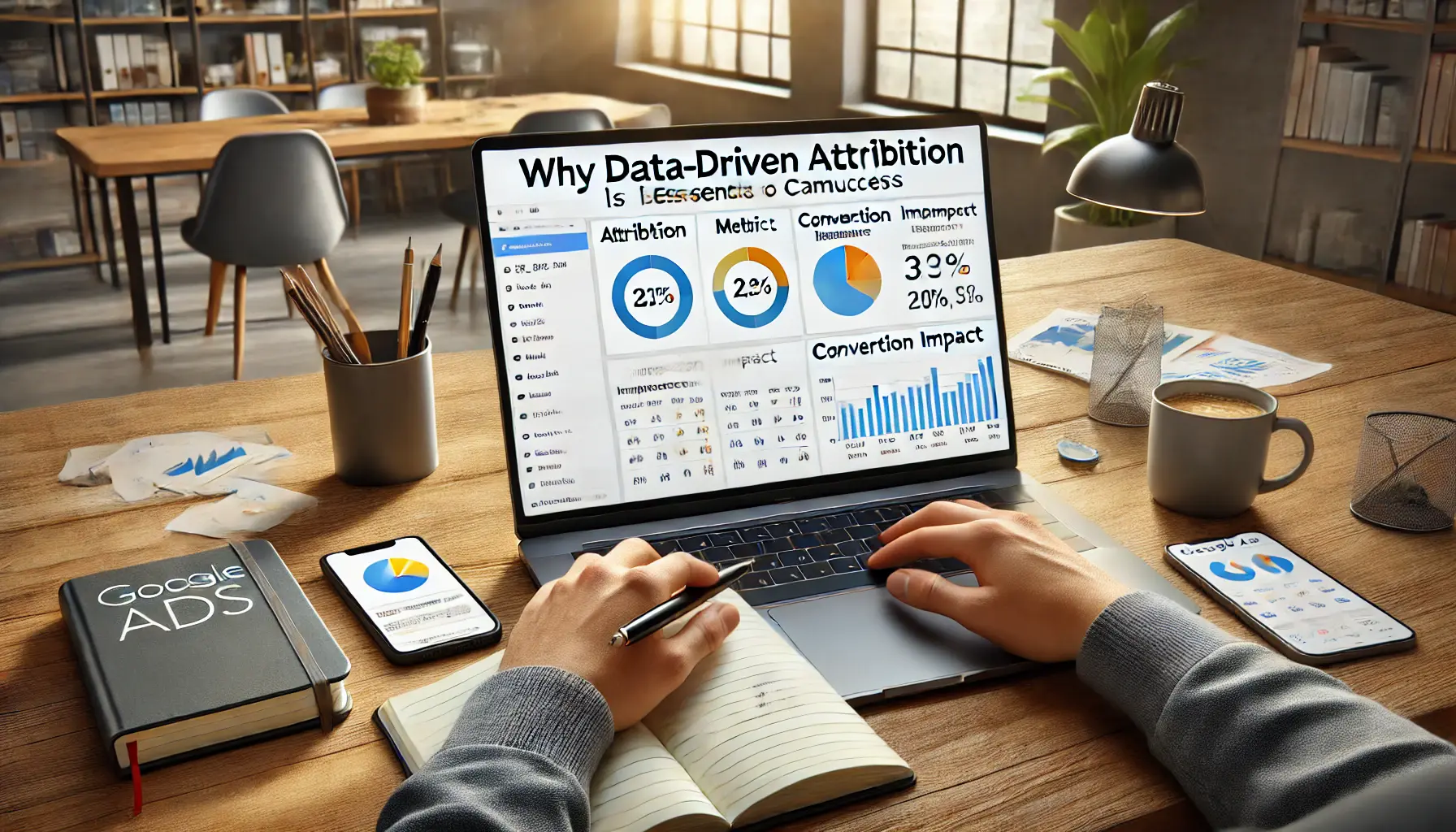
Understanding the impact of data-driven attribution on campaign effectiveness in Google Ads.
Why Data-Driven Attribution Matters for Your Campaigns
Data-driven attribution is more than just a model; it’s a comprehensive approach to understanding the effectiveness of your advertising.
By correctly attributing credit across multiple touchpoints, this model provides insights that last-click or rule-based models cannot offer.
With data-driven attribution, you can see how different ads and keywords contribute to a conversion, enabling more strategic budgeting, optimized bidding, and improved messaging.
Adopting data-driven attribution means embracing a dynamic, responsive strategy that adapts to your audience’s behaviors and evolving market trends.
As Google Ads continues to innovate and introduce new tools, data-driven attribution will remain a valuable asset in helping advertisers meet their performance and growth goals effectively.
Data-driven attribution empowers you to make informed decisions for higher-performing ad campaigns.

Exploring frequently asked questions about data-driven attribution in Google Ads.
Your campaigns can be managed by an agency specialized in Google Ads, check out our service page.
Commonly Asked Questions About Data-Driven Attribution in Google Ads
Data-Driven Attribution can be complex.
Below are some frequently asked questions to help you better understand how to apply and leverage this model in Google Ads.
Data-driven attribution is an attribution model in Google Ads that uses machine learning to allocate credit for conversions based on actual performance data from your campaigns.
Data-driven attribution considers the value of multiple touchpoints a customer interacts with along their journey, while last-click attribution assigns all credit to the last interaction before conversion.
Data-driven attribution requires a high volume of conversions to generate reliable insights, with minimum data thresholds set by Google for campaigns to qualify.
Data-driven attribution offers a more accurate representation of the customer journey, allowing for wiser budget allocations and ad strategy optimizations based on real data.
Yes, Google Ads allows you to compare models, enabling you to assess data-driven attribution against other models to find the best fit for your campaigns.
By accurately identifying high-impact touchpoints, data-driven attribution helps allocate budgets more effectively, leading to potentially higher return on investment.
Define goals based on business objectives, such as increasing conversions, sales, or customer engagement, to ensure insights are aligned with broader targets.
Yes, data-driven attribution supports cross-deviceRefers to tracking user interactions across multiple devices. tracking, providing a complete view of the customer journey across multiple devices.
Focus on tracking key conversions relevant to your business, such as purchases, sign-ups, or form submissions, to gain insights that directly impact goals.
Smaller advertisers may face data limitations, as data-driven attribution requires a substantial number of conversions to function effectively.
Review reports regularly, at least monthly, to ensure your campaigns align with changing trends and to optimize budget allocations based on performance data.
Use insights to adjust bids on high-impact keywords and implement automated biddingA Google Ads strategy where the system automatically sets bids to meet performance goals. strategies like target CPACost-per-acquisition bidding that targets a specific cost per conversion. or ROAS to maximize conversions.
Yes, Google Ads regularly releases new features and updates to improve attribution models, so stay informed to leverage enhanced tools as they become available.
Common issues include meeting conversion data thresholds, ensuring correct tag setup, and continuous performance monitoring to maintain data accuracy.
Google Ads provides assisted conversion data, which shows how certain ads or keywords contribute indirectly toward the conversion path without being the last interaction.
Use Google Ads’ model comparison tool to assess data-driven attribution against other models, gaining insight into its impact on your conversion data.
Data-driven insights reveal which messages resonate at each stage of the journey, allowing you to refine ad messaging to align with customer behaviors.
Conversion windows determine the timeframe within which conversions are attributed.
Adjusting windows can enhance data capture for more accurate insights.
Yes, data-driven attribution highlights top-performing channels and interactions, enabling budget reallocation across channels to improve overall campaign performance.










